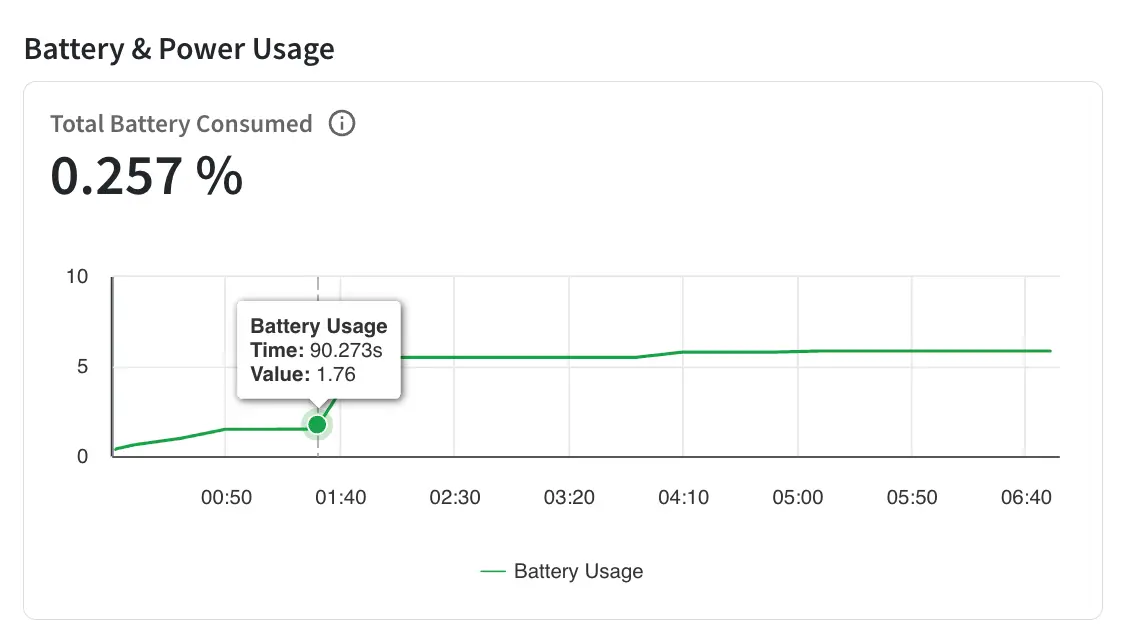iOS Battery & Power Usage
The Battery & Power Usage metric measures the device battery consumed by all the apps and processes running on the device during a session. It also shows the percentage of total battery consumed during the session. The percentage of total battery consumed is calculated by dividing the total battery consumed (mAh) over device’s total battery capacity.
The Battery & Power Usage metric for iOS applies to the entire system and isn’t tied to any particular application.
In the app performance report, go to the Battery * Power Usage section to view the overall battery consumption in the session. In the graph, the axes represent the following:
- X-axis: Depicts the time (in seconds) elapsed since the start of the session. 0 on the X-axis represents the start of the profiling session.
- Y-axis: Depicts the battery consumed (in mAh) by all the apps and processes running on the device till a particular time since the session started. Y-axis starts with 0 mAh.
Example
In the following example, you can see that the total battery consumed during the session was 0.257 % of the total battery capacity of iPhone 14 Pro. In the graph, you can see that till 90.273s since the session started, 1.76 mAh battery was consumed.

Impact on user experience
When apps drain too much battery, users tend to abandon them. Also, iOS might halt apps that excessively consume battery power. According to a Techbeacon survey, around 36% of app users have stopped using certain mobile apps specifically due to high battery usage.
Recommendations
-
Manage background activity efficiently:
- Minimize background processes. Limiting unnecessary activities running in the background conserves battery.
- Use background modes judiciously. Employ them only for essential tasks to prevent excessive battery drain.
- Optimize push notifications. Review and streamline notifications for better efficiency, reducing their impact on battery life.
-
Optimize networking and transfers for energy efficiency:
- Reduce the frequency of
NSURLSessionnetwork requests. Lowering the number of requests helps conserve battery power. - Efficiently use
URLSession. Optimize data transfers to minimize energy consumption while maintaining functionality.
- Reduce the frequency of
-
Optimize CPU and memory usage:
- Refine algorithms and calculations in Swift. Optimizing these elements decreases CPU usage, saving battery life.
- Employ Automatic Reference Counting (ARC). Use ARC to manage memory efficiently, reducing the drain on the CPU and conserving energy.
-
Enhance UI rendering efficiency:
- Utilize Core Animation and Core Graphics. Optimize rendering by leveraging these frameworks for efficient display handling.
- Reduce on-screen elements. Streamlining displayed elements enhances performance and minimizes battery usage.
-
Optimize location services:
- Use
CLLocationManagerthoughtfully. Limit frequent location updates to conserve battery life. - Adjust location accuracy settings. Fine-tune Core Location settings to balance accuracy and energy consumption effectively.
- Use
Related topics
We're sorry to hear that. Please share your feedback so we can do better
Contact our Support team for immediate help while we work on improving our docs.
We're continuously improving our docs. We'd love to know what you liked
We're sorry to hear that. Please share your feedback so we can do better
Contact our Support team for immediate help while we work on improving our docs.
We're continuously improving our docs. We'd love to know what you liked
Thank you for your valuable feedback!
